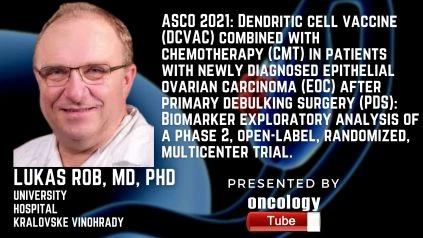Prof. Lukas Rob, MD, Ph.D., Head of Obstetrics and Gynecological Oncology at University Hospital Kralovske Vinohrady speaks about the ASCO 2021 Abstract – Dendritic cell vaccine (DCVAC) combined with chemotherapy (CMT) in patients with newly diagnosed epithelial ovarian carcinoma (EOC) after primary debulking surgery (PDS): Biomarker exploratory analysis of a phase 2, open-label, randomized, multicenter trial.
Link to Abstract:
https://meetinglibrary.asco.org/record/195562/abstract
Backstory:
Despite PDS and CMT, the majority of EOC patients recur. Tumor antigens can be presented via autologous DCVAC to induce a long-lasting immune response. The addition of DCVAC to CMT increases antitumor immunity and improves clinical results, according to our hypothesis.
Methodologies:
FIGO stage III EOC (serous, endometrioid, or mucinous), post-PDS with 1 cm maximum residuum, no prior systemic treatment, and ECOG 0-2 were the main qualifying criteria. Part 1 randomized patients 1:1:1 into arm A (DCVAC concurrent with CMT), arm B (DCVAC sequential after CMT), and arm C (DCVAC sequential after CMT) up to 6 weeks following PDS (C; CMT). Patients were divided into two groups based on the size of the tumor residuum (0 or 1 cm). Six cycles of carboplatin (AUC 5-7) and paclitaxel (175 mg/m2) were used in CMT. Up to ten doses of DCVAC (1107 DCs/dose) were given to patients in groups A and B. The primary outcome was progression-free survival as measured by radiology (PFS). Overall survival was a major secondary goal (OS). Patients who got 1 CMT dosage in C or 1 DCVAC dose in A and B were included in the protocol-defined modified intention-to-treat population (mITT).
Outcomes:
Between November 2013 and March 2016, 99 patients were randomly assigned to one of two groups. The mITT comprised 31 patients in group A, 29 patients in group B, and 30 patients in group C in the final analysis. The treatment groups had similar baseline characteristics and DCVAC exposure. The median PFS in A was 20.3 months, not achieved in B, and 21.4 months in C, with HRs (95 percent CI) of 0.98 (0.48-2.00) in A and 0.39 (0.16-0.96) in B when compared to C. B had a statistically significant PFS advantage (p = 0.034). A non-significant trend in OS in A and B corroborated this. At the time of the median follow-up of 66 months, no arm had attained median OS (34 percent of events). Patients in A and B who had low CD8+ T-cell counts (CD8Lo) in tumor samples had considerably better clinical outcomes than patients in C who had CD8Lo: median PFS gain of 6 months (19 vs 13 months) and a more robust OS increase (median not achieved vs 31 months), with no difference between A and B. This impact could not be explained by statistical variations in CD8+ T-cell counts (CD8Hi) density in patients with high CD8+ T-cell counts (CD8Hi). In both DCVAC groups, these data suggested the greatest clinical outcome in DCVAC patients with immunologically “cool” malignancies. With just 8 DCVAC-related adverse events, DCVAC has an excellent safety profile (Grade 1-2).
Findings:
DCVAC increased PFS and OS in patients with newly diagnosed EOC, particularly those with immunologically “cool” tumors, and so represents a viable therapeutic option in this patient population.
Clinical trial information: NCT02107937 –
http://clinicaltrials.gov/show/NCT02107937

